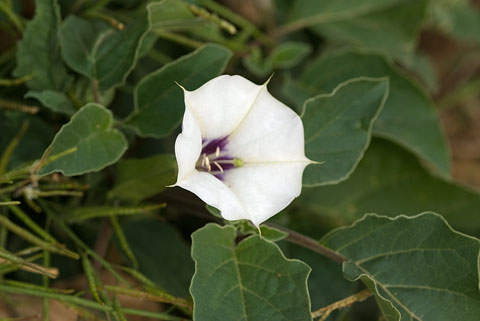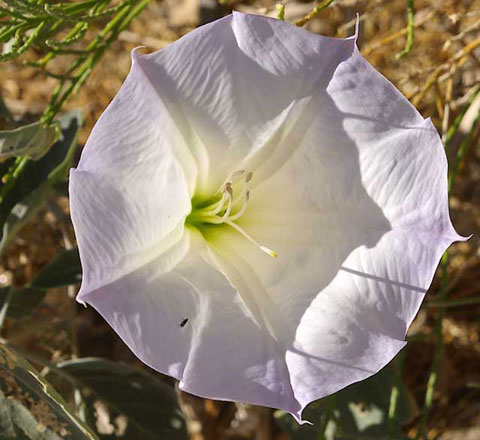
Home | Desert Plants & Wildflowers | Index | Solanaceae | Datura
Western Jimson Weed, Desert Thorn-Apple, Toloache, Datura
Only two of the nine species of Datura are found in Anza-Borrego. They are D. discolor and D. wrightii.

Desert Thorn-Apple, Datura discolor
Solanaceae

Western Jimson Weed, Datura wrightii
Solanaceae

Western Jimson Weed, Datura wrightii
Solanaceae

Western Jimson Weed, Datura wrightii
Solanaceae

Western Jimson Weed, Datura wrightii
Solanaceae
The flowers of D. wrightii are 6-8 inches long, while the flowers of D. discolor measure 4-6 inches. The calyx, the slightly shorter, green lower part of the flower, is ribbed toward the base in D. wrightii and 5-winged toward the base in D. discolor. Flowers of both species are white, often tinged with purple. There are purple markings inside the tube of the D. discolor flower. The meaning of discolor can be taken as variegated, tainted, or stained.
With a magnifying glass, you may notice that the D. wrightii flowers have hairs. D. wrightii can be a perennial or an annual, while D. discolor is always an annual.
The fruits of both plants are prickled, hence the often-used common name Thorn-Apple.
Datura species are known by a number of common names, with Jimson Weed being perhaps most often applied in the United States and Toloache in Mexico. Other names include Desert Thorn-Apple for D. discolor and Sacred Datura and Sacred Thorn-Apple for D. wrightii. The Checklist of the Vascular Plants of San Diego County, by Jon P. Rebman and Michael G. Simpson, published by the San Diego Natural History Museum and San Diego State University, uses Desert Thorn-Apple for D. discolor and Western Jimson Weed for D. wrightii.
The names Sacred Datura and Sacred Thorn-Apple are references to their ceremonial use by Hindus in India and Native Americans in the United States. In fact, the name Datura is a derivative of the Hindi name for the plant.
Native-American uses of such plants is well described in ethnobotany references such as Temalpakh: Cahuilla Indian knowledge and usage of plants, by Lowell John Bean and Katherine Siva Saubel, Chumash Ethnobotany: Plant Knowledge Among the Chumash People of Southern California, by Jan Timbrook, and Healing with medicinal plants of the west, by Cecilia Garcia and James Adams.
Anza-Borrego Desert Natural History Association
P O BOX 310 ( 652 Palm Canyon Drive) Borrego Springs, CA 92004-0310
Office 760-767-3052 | Desert Store & Nature Center 760-767-3098 | FAX 760-767-3099